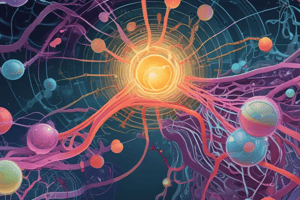Podcast
Questions and Answers
What is metabolism?
What is metabolism?
- Energy production in cells
- The sum of chemical reactions that occur within a cell (correct)
- The synthesis of complex molecules
- The breakdown of organic molecules
What is catabolism?
What is catabolism?
The breakdown of organic and inorganic molecules to release energy.
Define anabolism.
Define anabolism.
The synthesis of more complex molecules from simpler ones that requires energy.
What are the three major types of work carried out by cells?
What are the three major types of work carried out by cells?
What does Delta G represent?
What does Delta G represent?
Which statement describes exergonic reactions?
Which statement describes exergonic reactions?
What characterizes endergonic reactions?
What characterizes endergonic reactions?
What is adenosine triphosphate (ATP)?
What is adenosine triphosphate (ATP)?
Define activation energy.
Define activation energy.
What is oxidation in biochemical terms?
What is oxidation in biochemical terms?
What does reduction mean in redox reactions?
What does reduction mean in redox reactions?
What is a conjugate redox pair?
What is a conjugate redox pair?
What is the significance of standard reduction potential (E'0)?
What is the significance of standard reduction potential (E'0)?
What are electron carriers?
What are electron carriers?
Name a common electron carrier.
Name a common electron carrier.
Study Notes
Metabolism and Its Components
- Metabolism refers to all chemical reactions occurring within a cell.
- Catabolism involves breaking down molecules, releasing energy for use in other reactions.
- Anabolism is the synthesis of complex molecules from simpler ones, requiring energy input.
Cellular Work Types
- Three major types of work performed by cells:
- Chemical work: Involves anabolic processes.
- Transport work: Involves nutrient uptake.
- Mechanical work: Includes movement, such as flagellum rotation.
Free Energy and Reactions
- Standard Free Energy Change (ΔG) is measured under standard conditions: pH 7, 25°C, 1 atm pressure.
- Exergonic reactions have negative ΔG, releasing energy that can be harnessed for cellular work, such as ATP synthesis via phosphorylation.
- Endergonic reactions, characterized by positive ΔG, require energy input and often hydrolyze ATP to release energy.
ATP and Phosphates
- Adenosine Triphosphate (ATP) is a high-energy molecule synthesized during exergonic reactions.
- Orthophosphate (Pi) is the phosphate group added to ADP to form ATP.
Energy Activation and Catalysis
- Activation energy is the energy necessary to break chemical bonds, which can be lowered by catalysts like enzymes.
Redox Reactions
- Oxidation-Reduction (Redox) reactions are crucial for energy conservation, transferring electrons from donors to acceptors.
- Oxidation involves electron loss, while reduction signifies electron gain; remember OIL RIG (Oxidation Is Loss, Reduction Is Gain).
Redox Couples and Standard Reduction Potential
- A conjugate redox pair consists of an electron acceptor and donor.
- Standard Reduction Potential (E'0) indicates the tendency to donate electrons; more negative E'0 indicates a stronger donor.
- Redox Tower ranks couples based on E'0, with the most negative at the top and the most positive at the bottom.
Electron Carriers
- Electron carriers oscillate between reduced (electron-carrying) and oxidized (after transferring electrons) forms.
- Carriers are arranged in sequence based on their standard reduction potential in a process that maximizes energy release.
Common Electron Carriers
- Nicotinamide Adenine Dinucleotide (NAD+/NADH): Carries electrons and protons.
- Nicotinamide Adenine Dinucleotide Phosphate (NADP+/NADPH): Accepts 2 electrons and 1 proton.
- Flavin Adenine Dinucleotide (FAD/FADH) and Flavin Mononucleotide (FMN/FMNH): Carry 2 electrons and 2 protons, found in flavoproteins.
- Coenzyme Q (CoQ/Ubiquinone): Carries 2 electrons and 2 protons.
- Cytochromes: Contain iron to transfer 1 electron at a time.
- Iron-Sulfur Proteins (Ferredoxin): Use non-heme iron to transfer 1 electron.
Electron Transport Chain
- The electron transport chain transfers electrons from external initial donors to final acceptors, passing through carriers in an efficient membrane-embedded sequence.
- Found in the cell membranes of bacteria and archaea, as well as in the mitochondrial membranes of eukaryotes.
Studying That Suits You
Use AI to generate personalized quizzes and flashcards to suit your learning preferences.
Description
Test your knowledge on metabolism, cellular work, and energy changes! This quiz covers key concepts like catabolism, anabolism, free energy changes, and the role of ATP in cellular processes. Challenge yourself and deepen your understanding of essential biological reactions.




